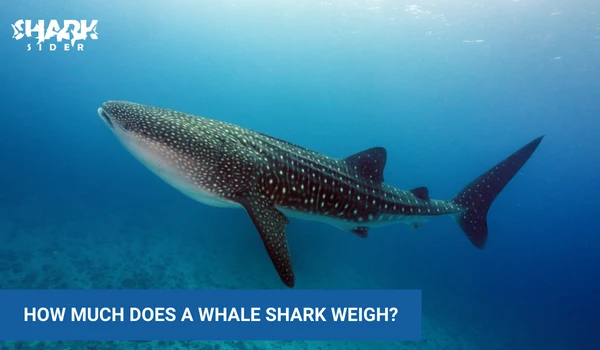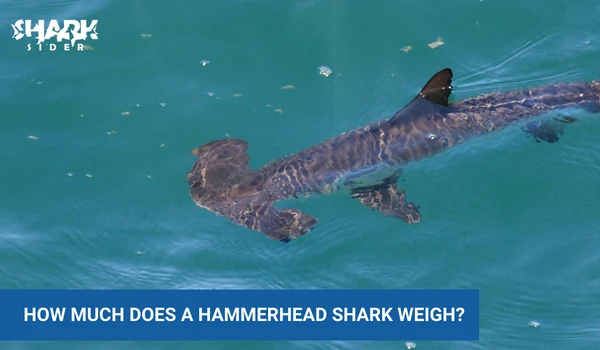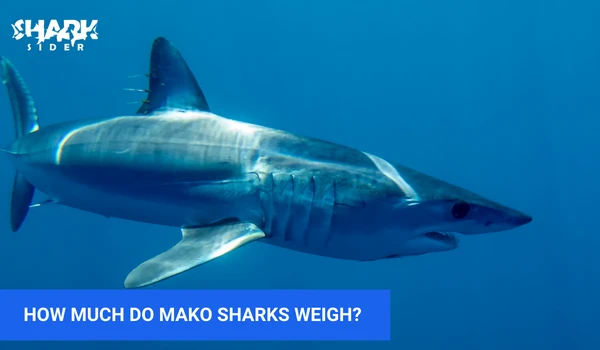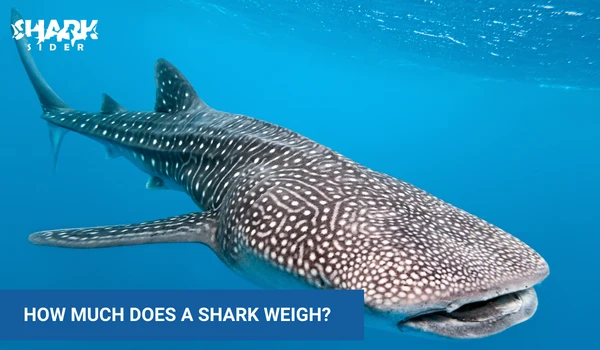Sharks are apex predators that can be found in all of the world’s oceans. They come in a wide variety of shapes and sizes, from the tiny Spined Pygmy shark (Echinorhinus brucus) that weighs just a few pounds to the massive Whale shark (Rhincodon typus) that can weigh up to 47,000 pounds.
In this blog post, we will take a look at the weight of different shark species. We will discuss the factors that affect a shark’s weight, and we will learn about some of the heaviest and lightest sharks in the world.
So, how much does a shark weigh? Read on to find out!
How heavy are sharks?
Sharks are fascinating creatures that come in all shapes and sizes, so it’s no surprise that their weight can vary greatly. On average, sharks weigh anywhere from a few pounds to several tons. However, the actual weight range can vary greatly depending on the species.
So what factors contribute to a shark’s weight? Body size and mass are of course major factors, but diet, habitat, and geographic location can also play a role. Some species of sharks are known to consume large amounts of food, resulting in higher body weight. Others may live in areas where food is scarce, causing them to be smaller and lighter.
Let’s check the factors that can influence a shark’s weight more closely.
Factors that affect a shark’s weight
- Age – The age of a shark can have a big impact on its weight. Younger sharks tend to be smaller and lighter, while older sharks may weigh more due to increased muscle mass.
- Sex – The sex of a shark can also influence its weight. Male sharks tend to be heavier than females, due to their larger size and greater muscle mass.
- Habitat – The habitat a shark lives in can also affect its weight. Sharks that live in waters with abundant food sources will often be larger and heavier than those that live in areas with limited food availability.
- Geographic Location – Sharks living in different geographic regions can also vary in size weight. Sharks living in warmer waters tend to be larger than those that inhabit colder regions.
- Diet – A shark’s diet can also contribute to its weight. Sharks that consume large amounts of food such as fish, squid, and crustaceans will often be heavier than those that consume smaller prey.
The heaviest sharks in the world
When it comes to the world’s heaviest sharks, there are some truly impressive creatures. In this section, we will take a look at some of these colossal creatures and explore their immense size and weight. So, let’s dive in and discover more about the heaviest sharks in the world!
How much does a Whale shark weigh?

The Whale Shark (Rhincodon typus) is the largest species of shark in the world and can reach an impressive length of up to 65 feet long. This giant species can weigh up to 47,000 pounds when fully grown, making it the heaviest shark in existence. Despite its massive size, the Whale Shark has a unique diet that sets it apart from other sharks.
Unlike its carnivorous counterparts, the Whale Shark is a filter feeder, primarily consuming plankton and small fish by filtering them through its wide mouth as it swims near the ocean’s surface. This gentle giant is known for its docile nature and is considered harmless to humans. Its enormous size and distinct feeding habits make the Whale Shark a true marvel of the ocean and a subject of fascination for marine enthusiasts and researchers alike.
How much do Great White sharks weigh?

Great White sharks are one of the most iconic and feared creatures of the sea. They are apex predators, meaning they are at the top of the food chain. They are also one of the largest sharks in the world, reaching lengths of up to 20 feet (6 meters) and weighing up to 4,000 pounds (1,814 kilograms). The diet of the Great White shark is primarily composed of marine mammals such as seals and sea lions, as well as other fish species. They are known for their impressive hunting abilities, often launching themselves from the depths of the ocean to surprise their prey near the surface.
Their powerful jaws, lined with rows of sharp teeth, allow them to capture and consume their prey with remarkable efficiency. The Great White shark’s carnivorous diet and formidable size make it a formidable and awe-inspiring predator, often evoking a mix of admiration and fear among those who encounter it in the wild.
How much does a Bull shark weigh?

Bull sharks are one of the most aggressive and dangerous sharks in the world. They can grow up to 14 feet (4.3 meters) long and weigh up to 2,000 pounds (907 kilograms). They are found in all of the world’s oceans, but they are most common in warm, shallow waters, such as estuaries and river mouths. In addition to their size and strength, Bull sharks are known for their opportunistic and diverse diet. They are often referred to as “the garbage disposals of the sea” due to their ability to consume a wide range of prey items.
Their diet can include fish, dolphins, turtles, birds, and even other sharks. Bull sharks are also known to venture into freshwater environments, where they can prey on animals such as fish, rays, and even mammals. Their versatile and voracious diet, combined with their powerful build, make Bull sharks formidable and adaptable predators in a variety of aquatic environments.
How much does a Tiger shark weigh?

Tiger sharks are one of the largest and most powerful sharks in the world. They can grow up to 18 feet (5.5 meters) long and weigh up to 2,000 pounds (907 kilograms). They are found in all of the world’s tropical and warm temperate seas, and they are known to be aggressive and dangerous predators. Tiger sharks have a diverse diet and are often referred to as “garbage cans of the sea” due to their ability to eat almost anything.
Their diet includes fish, seals, sea turtles, dolphins, and even other smaller sharks. They are also known to scavenge on dead animals and have been found with a wide range of items in their stomachs, including license plates, tires, and even pieces of boats. This opportunistic feeding behavior, combined with their large size and powerful jaws, makes Tiger sharks formidable predators in the marine ecosystem.
How much does a Hammerhead shark weigh?

Hammerhead sharks are a group of sharks that are characterized by their flattened, hammer-shaped heads. There are 10 different species of Hammerhead sharks, and they can range in size from 3 feet (0.91 meters) to 20 feet (6.1 meters) long. The largest species of the Hammerhead shark is the Great Hammerhead shark, which can weigh up to 1,300 pounds (589 kilograms). Hammerhead sharks are known for their unique feeding behavior, which involves using their wide heads to scan the ocean floor for prey, such as fish and rays, hiding in the sand or among rocks.
Their specialized head shape allows them to have an enhanced field of vision and improved sensory capabilities, making them efficient hunters. In addition to their primary diet of fish and rays, some species of Hammerhead sharks have been known to eat crustaceans and cephalopods as well. Their distinctive head shape, combined with their size and specialized feeding behavior, make Hammerhead sharks an interesting and formidable group of sharks in the ocean.
How much do Mako sharks weigh?

Mako sharks are one of the fastest sharks in the ocean, and they can reach speeds of up to 45 miles per hour (72 kilometers per hour). They can grow up to 12 feet (3.7 meters) long and weigh up to 1,200 pounds (545 kilograms). They are found in all of the world’s oceans, but they are most common in warm, tropical waters. Mako sharks are known for their voracious appetite and are known to be fierce hunters.
Their diet primarily consists of fish, including tuna, mackerel, and swordfish. They are also known to prey on other sharks, sea turtles, and even marine mammals. Mako sharks are known for their sharp teeth and powerful jaws, which they use to capture and consume their prey. Their speed, agility, and hunting prowess make them formidable predators in the open ocean ecosystem.
These are just a few of the heaviest sharks in the world. These gentle giants play an important role in the marine ecosystem, and should be respected and admired for their unique characteristics and vital contribution to the ocean’s balance. Understanding their size, weight, and diet is crucial in appreciating their ecological significance.
The lightest sharks in the world
As you can see, sharks are often thought of as being large and dangerous creatures, but there are actually a few species of sharks that are quite small. The lightest shark in the world is the Dwarf Lanternshark, which can grow to be only about 6 inches long and weigh less than a pound. Other light sharks include the Pygmy shark, the Spined Pygmy shark, and the Pygmy Ribbontail catshark. Let’s check out some of these smaller species of sharks that may not be as well-known, but are still fascinating in their own right.
How much does the Dwarf Lanternshark weigh?
The Dwarf Lanternshark (Etmopterus perryi) is the smallest shark in the world, reaching a maximum known length of just 20 cm (7.9 in) and weighing just 0.22 lbs (100 g). It is found in the deep waters off the coast of Colombia and Venezuela, at depths of between 283 and 439 m (928 and 1,440 ft).
The diet of the Dwarf Lanternshark mainly consists of small fish and invertebrates, such as krill, shrimp, and small squids. They are known to use their bioluminescent “lanterns” on their belly to attract prey in the darkness of the deep sea. These tiny sharks have specialized teeth adapted for grasping and consuming small prey, and their small size and slender body shape make them well-suited for navigating the dark and narrow spaces of the deep-sea environment.
Despite their size, the Dwarf Lanternshark serves an important ecological role in the deep-sea ecosystem, and further research and conservation efforts are needed to better understand and protect this fascinating species.
How much does a Spined pygmy shark weigh?
The Spined Pygmy shark (Squaliolus latitudes) is a small shark that can grow to be up to 28 cm (11 inches) long and weigh up to 0.33 lbs (150 g). It is found in all of the world’s oceans, but it is most common in deep, cold waters.
The Spined Pygmy shark feeds primarily on small fish, crustaceans, and cephalopods, such as squid and octopus. They have small, sharp teeth adapted for grasping and tearing prey, and their slender body allows them to navigate through narrow spaces in the deep-sea environment in search of food.
How much does a Pygmy Ribbontail catshark weigh?
The Pygmy Ribbontail catshark (Eridacnis radcliffei) is a small shark that can grow to be up to 25 cm (10 inches) long and weigh up to 0.44 lbs (200 g). It is found in the deep waters off the coast of Australia, New Zealand, and New Caledonia, at depths of between 200 and 600 m (660 and 2,000 ft).
The Pygmy Ribbontail catshark (Eridacnis radcliffei) has a diet that primarily consists of small fish, crustaceans, and cephalopods. As a bottom-dwelling shark, it hunts for prey on the seafloor, using its specialized teeth and jaws to capture and consume its food. Being a small shark, the Pygmy Ribbontail catshark feeds on relatively small prey items that are suitable for its size and habitat. Its diet and feeding habits are adapted to its deep-sea environment, where it navigates the darkness and hunts for food in the dimly lit depths of the ocean.
Conclusion
Sharks come in a variety of sizes and shapes, from the massive Great White shark to the tiny Dwarf Lanternshark. Each species plays an important role in the marine ecosystem, and further research is needed to better understand and protect these fascinating creatures.
While the great white shark may be the most well-known species of shark, there are many species of smaller sharks that can be just as interesting and surprising. From the Dwarf Lanternshark to the Pygmy Ribbontail catshark, there are many small species of sharks that may not be as well-known but are still fascinating in their own right. Each of these sharks is adapted to its environment, and each has a unique diet and behavior that makes it an important part of the marine ecosystem.
By learning more about these small sharks, we can better understand and appreciate their importance to the ocean. In doing so, we can help to ensure their continued survival in our oceans for generations to come.

